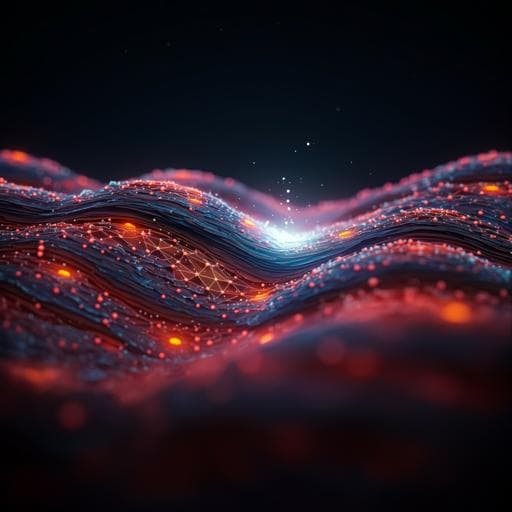
Physics
Tuning of charge order by uniaxial stress in a cuprate superconductor
L. Thomarat, F. Elson, et al.
Dive into the fascinating world of superconductivity! This research by Laure Thomarat and colleagues explores how uniaxial stress can enhance 3D superconductivity in La2-xBaxCuO4 while intriguingly maintaining charge stripes. Discover the delicate balance between charge order and superconductivity that might reshape our understanding of these materials.
~3 min • Beginner • English
Introduction
The study addresses how uniaxial stress tunes the competition and cooperation between stripe (spin and charge) order and superconductivity in cuprate superconductors. Stripe order consists of charge and spin density modulations that impact low-temperature properties and are believed to compete with 3D superconductivity, suppressing its critical temperature, while potentially stabilizing exotic pairing states. La2−xBaxCuO4 (LBCO) near x ≈ 1/8 is a model system where 3D superconductivity is strongly suppressed while 2D superconductivity within CuO2 planes persists, and a structural transition to a low-temperature tetragonal (LTT) phase occurs. Prior work showed that uniaxial compression along the Cu–Cu direction can restore/enhance 3D superconductivity and suppress magnetic order, and suppress tetragonal distortions that frustrate interlayer Josephson coupling. The research question is what happens to the charge order (CO) under such uniaxial compression and whether restoring optimal 3D superconductivity requires suppression or reconfiguration of charge stripes.
Literature Review
The paper situates its work within extensive prior research on intertwined orders in cuprates. Uniaxial stress has been used to manipulate competing phases, including inducing a 3D charge density wave in YBa2Cu3O7−x at zero magnetic field and controlling stripe domain populations in La2−xSrxCuO4 to confirm uniaxial stripe character and rule out checkerboard models. In LBCO near 1/8 doping, 3D Tsc is suppressed while CO and spin order are strong; CO has been observed across various cuprates and even outside the LTT phase, implying more general prerequisites (e.g., LTLO, weak monoclinic distortions) than strict LTT hosting. Uniaxial stress enhances Tc and affects CO in related Nd-doped La2−xSrxCuO4 systems, while muon spin rotation and neutron studies in LBCO show stress suppresses magnetic order. Structural studies report that stress suppresses the LTT phase and lifts geometric frustration. These works motivate a direct X-ray diffraction study of CO under uniaxial stress in LBCO to complete the stress–temperature phase diagram of structural, charge, and magnetic phases.
Methodology
Single crystals of La2−xBaxCuO4 with x = 0.115 were synthesized: polycrystalline precursors (La2O3, BaCO3, CuO) were reacted via solid-state methods and verified single-phase by powder XRD; single crystals were grown by traveling-solvent floating-zone. The crystal was cut/aligned with tetragonal [0,0,1] and [1,1,0] in the scattering plane (dimensions ~0.65 × 1.6 × 2.7 mm3) and glued to a uniaxial stress cell. Stress was applied along the long crystal axis at 45° to the Cu–O bond direction (i.e., along Cu–Cu), perpendicular to the scattering plane. Hard X-ray diffraction was performed at beamline P21.1 (PETRA III, DESY) with 101626 eV photons (λ ≈ 0.122 Å), enabling penetration of the cryomagnet environment to T ≈ 4.5 K and fields up to 10 T (effective B along c ≈ 8.7 T due to sample orientation). A linear-motor-based in-situ uniaxial device with feedback maintained constant force; temperature was measured on the cell near the sample. Stress transfer to the sample was verified by monitoring lattice constant changes with increasing force. Due to limited magnet windows (≈10° openings), the sample orientation was fixed to access the most intense CO peaks; measurements focused on Brillouin zones with favorable signal-to-background, primarily τ = (2,2,17) (HTT notation, a = b = 3.78 Å), and cross-checked at (1,1,9). CO peaks at QCDW = τ ± (δ,0,1/2) or (0,δ,1/2) were mapped using 2D detector reconstructions. Background from the sample environment was mitigated by choosing high-|Q| zones (|Q| > 15 r.l.u.) and by subtracting high-temperature datasets where CO is absent. Reciprocal-space maps were integrated perpendicular to the display plane by ~0.005 r.l.u. for presentation; for 1D cuts, data around the peak were integrated by 0.005 r.l.u. in h and 0.05 r.l.u. in l. The subtracted data were fit to a 3D Gaussian: I·exp[-ln2(h−h0)2/HWHM(h)2]·exp[-ln2(k−k0)2/HWHM(k)2]·exp[-ln2(l−l0)2/HWHM(l)2] + b, extracting amplitudes and half-widths (HWHM) along h, k, l. The background parameter b was free but consistently small (<2×10−4 cps), indicating effective subtraction. Due to instrumental constraints, subtle peak shifts could not be resolved; upper bounds were set to Δh ≤ 0.03 r.l.u., Δk ≤ 0.01 r.l.u., Δl ≤ 0.1 r.l.u. Positions were therefore fixed to ambient-stress values in fits. Measurements were performed at multiple temperatures and uniaxial stresses, both at zero field and under magnetic field (10 T).
Key Findings
- Charge order (CO) is present at all measured uniaxial stresses and temperatures where expected, but its intensity and coherence are strongly tunable by stress.
- Increasing uniaxial stress along the Cu–Cu direction suppresses the CO peak amplitude and reduces the correlation length specifically along the stripe propagation direction (reciprocal k), while leaving correlation lengths along the other two directions essentially unchanged.
- The suppression of CO amplitude and the reduction of the along-stripe correlation length proceed rapidly up to a critical stress σc ≈ 0.06 GPa (the stress where the LTT phase is fully suppressed); beyond this point the CO amplitude and widths saturate and remain unchanged upon further stress increase.
- The onset temperature of CO decreases only modestly with increasing stress up to σc and then remains nearly unchanged at higher stresses.
- Throughout, the CO peak position shows no resolvable shift within instrumental limits (upper bounds: Δh ≤ 0.03 r.l.u., Δk ≤ 0.01 r.l.u., Δl ≤ 0.1 r.l.u.), and there is no change in the c-axis modulation position or width.
- Application of magnetic field (10 T, effective ≈8.7 T along c) does not restore or enhance CO intensity in the uniaxially pressurized state; the field has minimal effect, consistent with a stress-stabilized balance between superconductivity and stripe order.
- The onset of CO tracks the onset of the LTLO structural phase under stress, indicating that LTT is not required for stripe formation; rather, LTT enhances the macroscopic extent of stripe-ordered regions.
- Overall, the restoration of optimal 3D superconductivity does not require eliminating charge stripes; instead, it is associated with weakening CO and partitioning into smaller domains up to an optimal limit near σc.
Discussion
The results directly address how uniaxial stress modifies the interplay between superconductivity and charge stripes in LBCO near 1/8 doping. Restoring optimal 3D superconductivity at σ ≈ 0.06 GPa coincides not with a disappearance of CO but with a substantial reduction in its amplitude and, crucially, a shortening of the correlation length along the stripe propagation direction. This anisotropic reduction likely alleviates the stripe-induced frustration of interlayer Josephson coupling without fully removing stripe order, enabling coherent 3D d-wave superconductivity. The persistence of CO above σc, with a modestly reduced onset temperature that tracks the LTLO transition, shows that LTT is not necessary for stripe formation, although it enhances the spatial extent of stripe regions. Differences between charge and spin channels are noted: whereas spin order volume fraction can recover at low temperatures, the CO intensity saturates to a lower value under stress, suggesting distinct couplings of superconductivity to charge versus spin components of stripe order. The absence of c-axis peak shifts or sharpening rules out a simple in-phase interlayer alignment scenario under stress. The lack of magnetic-field enhancement of CO in the stressed state implies that stress drives the system to an energetically balanced configuration of intertwined orders, consistent with other observations (e.g., disorder raising Tc while reducing stripe coherence, and cases where suppressing superconductivity enhances CO). These findings highlight the importance of the characteristic length scale over which stripes are correlated for maximizing coherent 3D superconductivity.
Conclusion
Uniaxial compression along the Cu–Cu direction in La1.885Ba0.115CuO4 suppresses charge order intensity and shortens its correlation length along the stripe direction up to a critical stress (≈0.06 GPa) that restores optimal 3D superconductivity; beyond this stress, CO properties and onset temperature saturate while CO persists. The enhancement of superconductivity thus does not require eliminating charge stripes but corresponds to their rearrangement into smaller, less correlated domains. CO tracks the LTLO structural onset under stress, indicating LTT is not required for stripe formation. The stressed state is robust against further compression and magnetic fields, suggesting a subtle, cooperative balance among superconducting, spin, charge, and lattice degrees of freedom. Future work should probe anisotropic stress directions with weaker superconducting impact, explore real-space inhomogeneity and domain-wall pinning effects, and investigate related intertwined orders (e.g., PDW) under uniaxial pressure.
Limitations
- Instrumental resolution and geometry did not allow resolving small stress-induced shifts of the CO peak position; only upper bounds were established (Δh ≤ 0.03 r.l.u., Δk ≤ 0.01 r.l.u., Δl ≤ 0.1 r.l.u.).
- Magnet window constraints limited reciprocal-space access and field orientation (effective field along c ≈ 8.7 T), and the magnet contributed substantial background requiring high-temperature subtraction.
- Measurements focused on select Brillouin zones and on stress applied along the Cu–Cu direction; the response for other stress orientations remains to be tested.
- The study concentrates on a single doping (x = 0.115); generalization across dopings and compounds requires further investigation.
- X-ray diffraction provides averaged reciprocal-space information; real-space domain morphology and nanoscale inhomogeneity are inferred indirectly rather than imaged directly.
Related Publications
Explore these studies to deepen your understanding of the subject.







